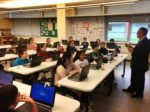Generation Z is the latest generation of students to go through the education system. This tech-savvy generation is keen to use technology, but they need guidance to help them make the most of its benefits.
Here are some tips for using technology to improve Gen Z student learning.
Who Is Generation Z?
Though the exact definitions vary, the term Generation Z generally refers to a person born between 1996 and 2012, and they are between the ages of 5 to 21 years old right now. The defining feature of Generation Z is that they use technology in almost every facet of their lives, including education. Thanks to this focus on technology, lesson plans can be customized, and past work can be mined for data that can pinpoint weaknesses and bolster effective learning patterns, increasing their chances at academic achievement. There is no doubt that Generation Z is poised to be the most technologically savvy generation to date.
Apps in the Classroom
According to a study, around 80 percent of educators see apps as a way to engage students, while only about 51 percent of students share this opinion. This discrepancy can be traced back to students viewing educational apps as less interesting than their favorite recreational apps. At the same time, 97 percent of teachers surveyed said they encourage students to work with learning websites and apps for homework, independent study, and test preparation. When using apps, 57 percent of teachers noticed improved study habits, 66 percent noticed the kids had more fun, and 76 percent noted more student engagement. Many parents have noticed similar trends. To help encourage kids to work on their homework, parents can take an interest in the technology their kids use in the classroom and ensure their kids can access it outside of school.
Tips for Using Apps to Help Kids Learn
Here are a few things to know about apps and using them at school and at home.
Apps Should Work Together
Apps like Evernote, Penultimate, Dropbox, Flipboard, Twitter, and Pocket all work together seamlessly. Also, iBooks, PDFs, and apps like iAnnotate are made to work together. Using these kinds of apps can help streamline kids’ learning.
Make Discovery the Goal
With so many digital tools, apps, and platforms available, students need to be given space to discover new apps that do different things. Make a space and time for finding new apps and talking about them with your children or teens. There are many directories available for parents to find apps to share with their kids.
Avoid Apps That Involve In-App Purchase Scams
There are times when an app can offer additional content in the form of in-app purchases. However, other apps often use them to milk money from users. These apps aren’t usually worthwhile, as their designers are much more focused on getting money than putting out a useful product.
Look for Apps That Support Independent Learning
Thanks to apps, there is a pronounced shift from class-focused learning to heutagogy or self-determined learning. Parents can support their kids’ learning by giving students the tools they need to explore new concepts.
By properly utilizing apps and online learning tools, parents can support and communicate with Generation Z students effectively.
Online Learning for Generation Z Students
“New modes of online learning will cater more effectively to Generation Z,” Time.com reported in 2015. Kids in this generation may not be as suited to a traditional brick-and-mortar school. “The oldest Gen Z-ers have been forced into an industrial model of school, and we are seeing all these attention problems,” Erica Orange, executive vice president of The Future Hunters, a futurist consulting firm, told Time.com. “Their brains are wired differently and actually function better with input from a variety of sources.”
If you are the parent of Generation Z students, you may find that they learn better with the use of technology. Generation Z students may do particularly well in an online learning environment, which tend to have both a technology and independent learning focus. Visit K12.com for more information on virtual public and private schools.




































